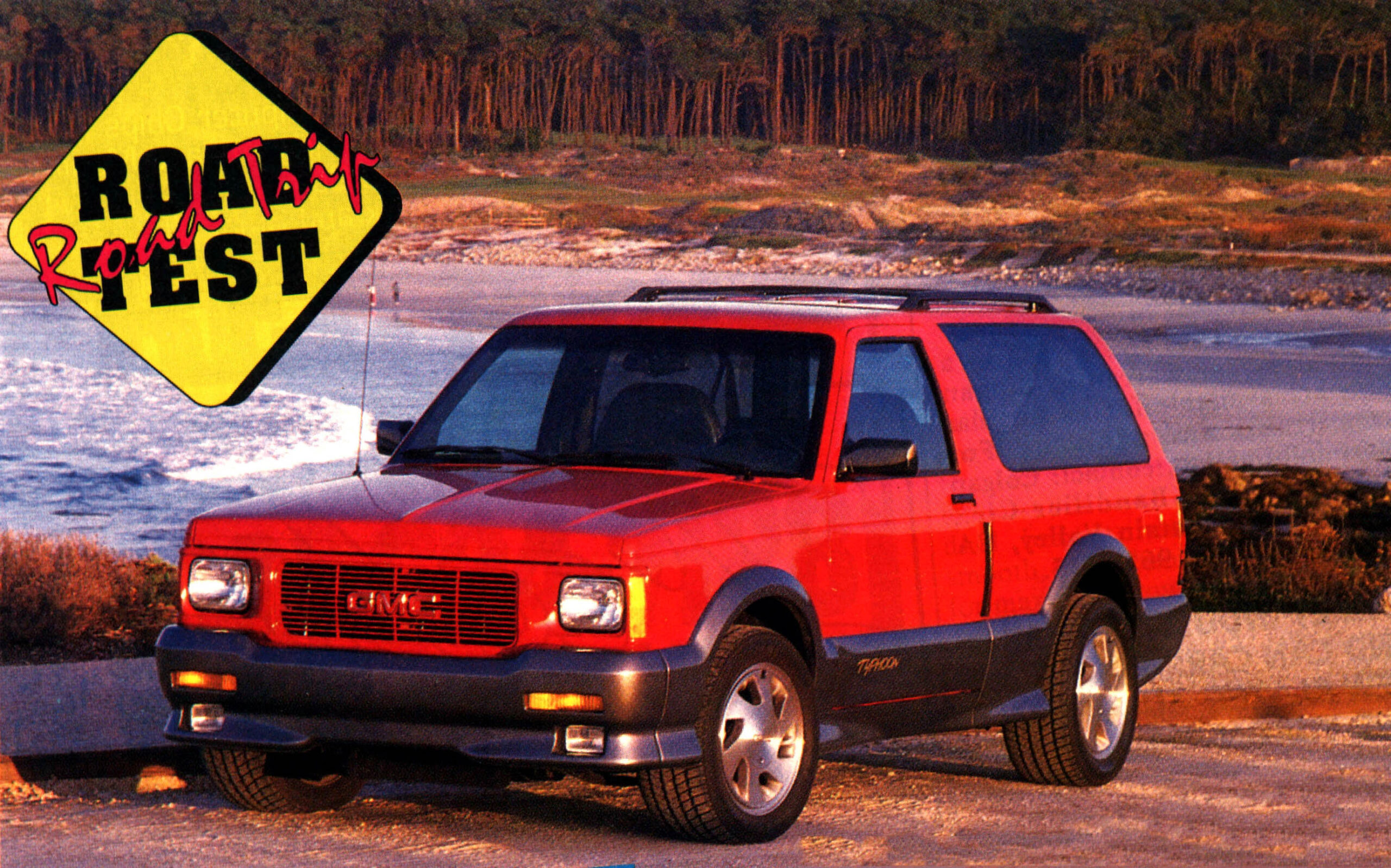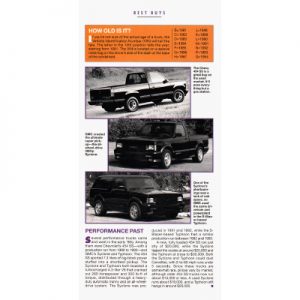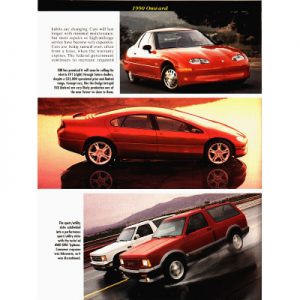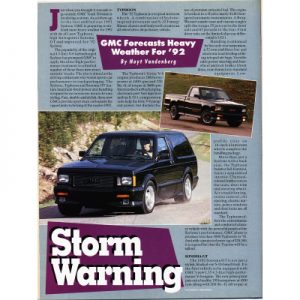Truck & Sport Utility Performance

When describing the Typhoon adjectives like; awesome, intense, adrenaline rush and mind-blowing come to mind. Have these appraisals been made in haste, after one quarter-mile blast or 0-60 sprint? When we lined up our ’93 tester, we scheduled it around a getaway so we could subject the Typhoon to our Road Trip Road Test. This would enable us to evaluate the vehicle on a five hour trip to Carmel as well as five second trips to 60 mph. We would endeavor to look beyond the truck’s acceleration and handling performance, if possible, and report or, comfort, ride and day-in and day-out performance.
The ’93 version of the Typhoon has been refined and improved by r -_- GMC engineers. The lion’s share of the refinements were to the interior. The Typhoon is now equipped with an overhead console that houses two reading lamps and nifty storage bins for sunglasses and a remote garage door opener. Standard seating consists of leather-trimmed buckets. The driver’s seat features six-way power adjustment and power lumbar support. The passenger side bucket also comes with power lumbar adjustment. In the cargo hold of the Typhoon a webbed nylon netting keeps pack ages and gear secured. Considering the high probability of spirited driving this is a most useful addition. There are two exterior changes worth noting. The first is the addition of a body-color grille that unifies the front of the truck. The second is a monochromatic white-on-white color package. The only design change that effects performance is a retuned rear suspension that increases road feel and lateral acceleration.
When looking at the performance ledger, the Typhoon lives up to the adjectives used at the beginning of this article. The truck is so quick that sometimes it’s difficult to find the adjectives to describe it. The Typhoon’s speedo needle sweeps across the dial faster than most truck’s tach needles. The GMC’s blistering performance comes from the potent 285-horse, turbocharged and intercooled Vortec V6. Peak horsepower is realized at 4400 rpm and torque is rated at 360 lbs/ft at 3600 rpm. At idle the engine conveys a sense of eagerness to the driver. Slip the 41-60 into gear and the truck lurches forward in anticipation. What transpires next is totally up to the driver. A swift push to the floor with the right foot and your back is pinned to the seat. Our empirical testing netted some impressive results. We posted 0-60 times of 5.4, 5.6 and 5.8 seconds. The scorching 5.4-second run ate up 269 feet of road and registered a whopping 1.016gs off the line. But the motor idles quite smoothly and will behave in a more civilized manner when that necessity arises. It can creep away from stoplights slow enough to make people think a little old lady from Pasadena is at the wheel. No matter how the truck is utilized, the Typhoon owner doesn’t pay the price at the pump. With EPA estimates of 14 mpg city and 18 mpg highway, our Typhoon was right on the mark, checking in with an average of 16 mpg. These figures are about average for the sport/utility market segment.
A major factor in acceleration performance is being able to transfer the power generated in the engine bay through the drivetrain and onto the pavement. The smooth but concise shifts of the 4L60 four-speed automatic with overdrive combined with the Borg- Warner 4472 all-wheel drive transfer case with viscous coupling give the Typhoon sure-footed traction despite road conditions. The unit is set up to funnel 35-percent of the available power to the front wheels and 65-percent to the rear. The Borg-Warner 4472 limits wheel spin during hard acceleration and enhances cornering by using the viscous coupling to distribute power to the wheel with the best grip, which improves adhesion.
A key player in adhesion and traction is the suspension. The unequal-length control arm with torsion bars and stabilizer bar front independent suspension and two-stage, semi-elliptic multi-leaf spring rear suspension with electronic load-leveling shocks and integral air bags works hard keeping the tires in contact with the road, yet provides a soft, confident ride. Many sport-tuned cars produce their performance by sacrificing ride comfort, the Typhoon is one of the few performance vehicles that truly blends ride and handling. The ’93 revisions are noticeable, the suspension conveys a sense of intelligence, knowing when it needs to be firm and when it needs to be soft. When the Typhoon’s cornering capabilities are challenged, the suspension reacts quickly and confidently to driver input. The massive P245/50VRl6 Firestone Firehawk SVX tires prove their worth, clawing through apex after apex with little effort. The components work as one, making the Typhoon feel like it’s riding on rails. On the open highway the GMC glides over road irregularities and expansion joints. Even potholes are endured without concern. As the longest leg of our road trip came to an end, we found ourselves fresh and ready for a night on the town.
The smoothness of the truck’s ride is only partially responsible for the comfort of the Typhoon. Often in performance vehicles interior creature comforts are overlooked entirely or are afterthoughts at best. The Typhoon’s interior is impressive, but usually overshadowed by the truck’s outrageous performance. Everything you touch is leather; the seats, door panels, steering wheel and shifter knob. The driver’s bucket seat is six-way power adjustable, including lumbar support. While some “adjustable” seats contort into every imaginable position except one that is comfortable, these seats are standouts. They didn’t cut off circulation to the lower extremities after hours in the saddle and were up to the task when the Typhoon was driven to the edge, providing excellent lateral support. One of the most appreciated interior upgrades is the stylish gauge cluster, originally offered in the now defunct Syclone and Sonoma GT pickups. The cluster features traditional sweep-needle, dial-style gauges not the hard-to-read bar-graph units offered in tamer GM S-series sport/utilities. The Typhoon has room to comfortably seat five and does live up to the “utility” portion of its name as well as the “sport’. With the rear seats in place there is 28.1 cubic-feet of cargo area. Fold down the seats, and the Typhoon can carry 67.2 cubic-feet of groceries or cargo. The Typhoon has a modest 900-pound payload and no available towing capacity. The Typhoon’s MSRP is in the $29,000 ballpark, we have seen fully loaded minivans with similar price tags. One reason many potential buyers are forced to decide against the GMC is its configuration. Minivan’s have sliding rear doors while the Typhoon is available only in two-door configuration. While this may change, rumor has it that a four-door Typhoon test mule has been developed by PAS, Inc. the company that installs the turbos and other Typhoon-exclusive parts for GMC. Imagine that, the best of both worlds, a vehicle that can quicken the pulse to the tune of 0- 60 in under six seconds and accommodate the needs of a growing family, car seat and all.





